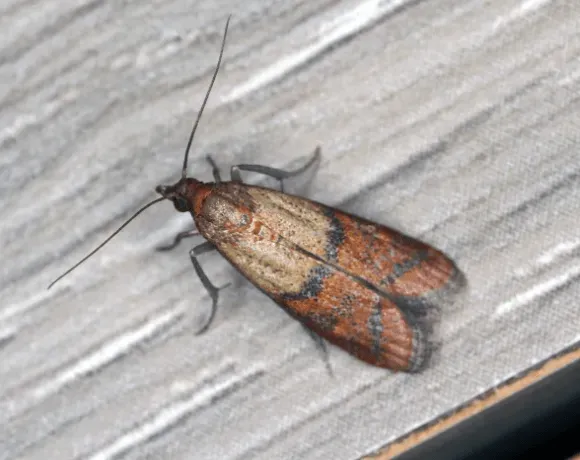Indianmeal Moths: 4 Misconceptions About This Pantry Pest

The Indianmeal moth is a very common pest in the United States. These moths and their larvae infest pantries and other areas of the home where dry food goods are stored, and they are also called Weevil moths, pantry moths, flour moths, and grain moths.
The telltale signs that you have an Indianmeal moth infestation in your pantry are the presence of adult moths in your house — especially if they are near your food storage area, about 1/2-inch long moth larvae inside of your food containers, and fine silk-like webbing in your dry food items.
Read on to learn about four Indianmeal moth misconceptions you may have heard and how to eradicate your pantry infestation.
Myth #1: Indianmeal Moths Only Infest Unsanitary Households
Many homeowners who discover that their pantries are infested with Indianmeal moths suspect that they could have avoided the infestation by keeping their pantry cleaner. Others attempt to avoid a second infestation after the first one has been eradicated by simply keeping their pantry as clean as possible.
The truth is that these pantry pests can infest even very clean and sanitary food storage areas. Indianmeal moth infestations sometimes begin when a homeowner unknowingly purchases a food item from a grocery store that is infested with Indianmeal moth larvae or eggs, then places the food item in the pantry. Larvae living in the infested item then burrow out of the food package and into the packages of other food items stored in the pantry.
To avoid an Indianmeal moth infestation, check all food items you purchase at the grocery store for moth signs before you bring them home. The most common sign that moth larvae may be present in a dry food item is damaged packaging, especially if this damage consists of small holes that larvae created when they burrowed through the packaging.
While moth larvae enjoy feasting on grains, including cereals, flour, pasta, and crackers, they can also be found in powdered milk, dried fruit, dried herbs, and even dry pet foods.
Myth #2: Eating Indianmeal Moth Larvae Can Get You Sick
When many people discover that they have an Indianmeal moth pantry infestation, they panic when they realize they may have accidentally consumed moth larvae or eggs before the infestation was discovered and worry that they will become ill.
Many pests are covered in bacteria that they transfer onto household surfaces or produce excrement contaminated with viruses or parasites, but Indianmeal moths are not known to spread any known diseases, pathogens, or parasites.
For this reason, consuming moth larvae, eggs, webs, and even excrement typically won’t cause illness in a human or a pet.
Myth #3: All Indianmeal Moth Larvae Look Alike
Since one adult female Indianmeal moth can lay up to 400 eggs that hatch into larvae in just 2 to 14 days and full-grown Indianmeal moths do not eat at all during their short 5-7 day lives, you will find many more moth larvae during an Indianmeal moth infestation than adult moths.
These larvae are typically off-white in color with brown heads, so if you find larvae of various colors in your pantry, you may become confused and think your pantry is infested with many different types of moth. However, Indianmeal moth larvae are not always off-white in color, because some take on the color of the food they are eating.
Do not be surprised if you also find larvae that are pink, brown, or green, because Indianmeal moth larvae of these colors have been identified in some infestations.
Myth #3: These Moths are Easily Killed with Home Remedies
The first step to eradicating Indianmeal moths from your home is to throw out all infested food items, but additional steps need to be taken to kill all larvae and eggs that may still be present in the pantry. If any eggs or larvae are still present in the pantry when new food items are brought in, the larvae can easily burrow their way into the new food items and begin a brand-new infestation.
While you may find many home remedies for Indianmeal moth infestations online, these moths, larvae, and their eggs are sometimes difficult for even exterminators to kill and are resistant to many chemical and biological insecticides. That means that home remedies may not always be 100 percent successful.
Instead of trying home remedies that are less likely to work on an extensive infestation, contact a pest control expert who can give you sound advice on how to tackle the infestation or who can eliminate the bugs with the right chemical or biological insecticides.
Indianmeal moth pantry infestations are very common in Minnesota and the entire United States. Forget these four misconceptions about these pantry pests and contact the pest control experts at Paffy's Pest Control for help to eradicate your Indianmeal moth infestation today.







